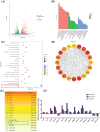Lenalidomide regulates the CCL21/CCR7/ERK1/2 axis to inhibit migration and proliferation in diffuse large B-cell lymphoma
- PMID: 39735670
- PMCID: PMC11671405
- DOI: 10.32604/or.2024.050036
Lenalidomide regulates the CCL21/CCR7/ERK1/2 axis to inhibit migration and proliferation in diffuse large B-cell lymphoma
Abstract
Background: The prognostic significance of the chemokine receptor CCR7 in diffuse large B-cell lymphoma (DLBCL) has been reported previously. However, the detailed mechanisms of CCR7 in DLBCL, particularly regarding its interaction with lenalidomide treatment, are not fully understood.
Methods: Our study utilized bioinformatics approaches to identify hub genes in SU-DHL-2 cell lines treated with lenalidomide compared to control groups. Immunohistochemical data and clinical information from 122 patients with DLBCL were analyzed to assess the correlation of CCR7 and p-ERK1/2 expression with the prognosis of DLBCL. Furthermore, in vitro and in vivo experiments were conducted to clarify the role of CCR7 in the response of DLBCL to lenalidomide treatment.
Results: Our bioinformatics analysis pinpointed CCR7 as a hub gene in the context of lenalidomide treatment in DLBCL. Notably, 31.14% and 36.0% (44/122) of DLBCL cases showed positive expression for CCR7 and ERK1/2 respectively, establishing them as independent prognostic factors for adverse outcomes in DLBCL via multivariate Cox regression analysis. Additionally, our studies demonstrated that the external application of the protein CCL21 promoted proliferation, migration, invasion, and activation of the ERK1/2 pathway in SU-DHL-2 and OCI-LY3 cell lines with high levels of CCR7 expression. This effect was mitigated by CCR7 silencing through siRNA, application of ERK inhibitors, or lenalidomide treatment. In vivo experiments reinforced the efficacy of lenalidomide, significantly reducing tumor growth rate, tumor mass, serum total LDH levels, and expression of CCR7 and p-ERK1/2 in a SU-DHL-2 xenograft model in nude mice (p < 0.05).
Conclusion: Our study clarifies the potential role of the CCL21/CCR7/ERK1/2 axis in the therapeutic effects of lenalidomide in DLBCL treatment.
Keywords: CCL21; CCR7; Diffuse large B-cell lymphoma (DLBCL); ERK1/2; Lenalidomide.
© 2025 The Authors.
Conflict of interest statement
The authors declare no conflicts of interest to report regarding the present study.
Figures






Similar articles
-
CCL21/CCR7 interaction promotes cellular migration and invasion via modulation of the MEK/ERK1/2 signaling pathway and correlates with lymphatic metastatic spread and poor prognosis in urinary bladder cancer.Int J Oncol. 2017 Jul;51(1):75-90. doi: 10.3892/ijo.2017.4003. Epub 2017 May 17. Int J Oncol. 2017. PMID: 28534984 Free PMC article.
-
Chemokine (C‑C motif) ligand 21/C‑C chemokine receptor type 7 triggers migration and invasion of human lung cancer cells by epithelial‑mesenchymal transition via the extracellular signal‑regulated kinase signaling pathway.Mol Med Rep. 2017 Jun;15(6):4100-4108. doi: 10.3892/mmr.2017.6534. Epub 2017 May 2. Mol Med Rep. 2017. PMID: 28487957 Free PMC article.
-
Low dose of lenalidmide and PI3K/mTOR inhibitor trigger synergistic cytoxicity in activated B cell-like subtype of diffuse large B cell lymphoma.J Exp Clin Cancer Res. 2016 Mar 24;35:52. doi: 10.1186/s13046-016-0327-x. J Exp Clin Cancer Res. 2016. PMID: 27009084 Free PMC article.
-
Lenalidomide combined with R-GDP in a patient with refractory CD5-positive diffuse large B-cell lymphoma: A promising response and review.Cancer Biol Ther. 2018 Jul 3;19(7):549-553. doi: 10.1080/15384047.2018.1449609. Epub 2018 Apr 13. Cancer Biol Ther. 2018. PMID: 29611764 Free PMC article. Review.
-
CCL21/CCR7 axis as a therapeutic target for autoimmune diseases.Int Immunopharmacol. 2023 Aug;121:110431. doi: 10.1016/j.intimp.2023.110431. Epub 2023 Jun 16. Int Immunopharmacol. 2023. PMID: 37331295 Review.
References
-
- Desai, S. H., LaPlant, B., Macon, W. R., King, R. L., Wang, Y.et al. (2021). Lenalidomide in combination with R-CHOP produces high response rates and progression-free survival in new, untreated diffuse large B-cell lymphoma transformed from follicular lymphoma: Results from the Phase 2 MC078E study. Blood Cancer Journal , 11(9), 160. 10.1038/s41408-021-00542-z; - DOI - PMC - PubMed
MeSH terms
Substances
LinkOut - more resources
Full Text Sources
Miscellaneous
